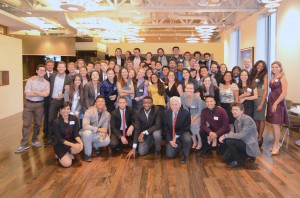SISE 2014: What I learned

In April of 2014 my project advisor at the Office of Sustainability, Ashlyn Hochschild, emailed out several different opportunities to get more involved in the sustainability realm. One of the things listed in the email was the Summer Institute on Sustainability and Energy (SISE) at the University of Illinois at Chicago, a two week intensive for undergraduate seniors, graduate students, and sustainability professionals focusing on renewable energy and the sustainability of those energy practices. Not having anything to lose, I decided to apply. Fast-forward four months and a very intense application process later I was boarding a 6am flight to Chicago.
SISE provides a unique learning opportunity for the 50-60 people selected to participate every year by combining interesting lectures, unique research projects, and amazing field trips. The lectures we attended were given by some of the top energy and sustainability professionals in the Chicago area with topics that ranged from sustainable airports to batteries to the importance of business and entrepreneurship in the field. Not only did these top professionals lecture us, but also they acted as mentors for the duration of the program.
For the group research project we were given a problem to research and solve in our assigned groups over two weeks relating to the theme of Urban Energy. We were mentored, presented, wrote business plans and what resulted was twelve groups with twelve great ideas. This project gave everyone an opportunity to explore an unfamiliar topic and to gain the experience of accomplishing a large task in a short amount of time while also building our professionalism skills.
The last main learning component of the program is the field trips. We visited a total of three sites in Chicago during our two-week stay: Illinois Institute of Technology, O’Hare international Airport, and Argonne National Laboratory. Each site showed us what sustainability looks like in the real world, specifically the energy field. Between learning about the smart grid technology already available at IIT, the goats and sheep kept at O’Hare, and seeing the Advanced Photon Source and Transportation Labs at Argonne, the participants gained a true understanding of how the world is beginning to make a change towards a more sustainable future.
I knew when I accepted my invitation to attend the fourth annual SISE I would be exposed to new ideas and learn so much from the lectures and field trips, but I would have never expected that I would learn the most from the other participants. Living with 60 strangers for two weeks seems like it could end in disaster, however working, learning and living with everyone 24 hours a day gave me a better understanding of the world and sustainability. When we weren’t in lectures or on trips everyone would go explore the wonderful city we were in. Somewhere between waiting 90 minutes to try Chicago’s famous pizza, stuffing too many people in a sketchy cab, arriving to the park to hear live music about a minute before it ends, finding a random band playing swing music on the sidewalk and dancing with new friends, watching fireworks off Navy Pier, staying up until 6am in the dorm singing in 15 different languages and dancing, having cook-outs, taking too many selfies, seeing the Air & Water Show, playing Cards Against Humanity and Hanabi, and just having wonderful conversations with people, the participants of SISE 2014 became a family. The feeling I had at
SISE is one I hope everyone can experience at some point in their life. Being in the realm of environmental studies and sustainability comes with a lot of negativity but being surrounded by people who have the same goal of bettering the world, I have never felt more hopeful about the outlook of our existence on this planet.
One the first day of SISE, I walked into aconversation between participants on the physics of the organic chemistry of some type of renewable energy and I thought I was accepted by mistake. That conversation was my first exposure of many to the great minds of chemistry, physics, mathematics, economics, policy, business, geography, architecture, and so much more that made up the participants of SISE 2014 who taught me so much about the world and myself. Three weeks after SISE ended, I still miss the family I gained there, but I know that in our respective areas of the world we will still be working together to make a difference. – Virginia Whorley, Sustainability Intern



